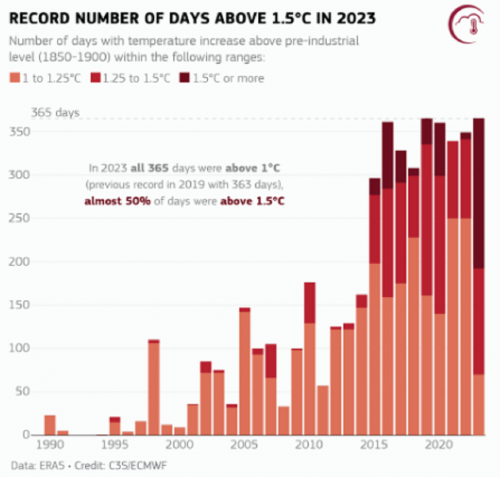Close to 50% of the days in 2023 were 1.5°C warmer than 1850-1900, compared to just over 20% in 2016
The year 2023 was the first in history when every day the average daily temperature was at least a degree higher than the average of the preindustrial period from 1850-1900.
Close to half the days in 2023 were in excess of 1.5°C warmer than 1850-1900. This was the case for just over 20 per cent of the days in 2016, the previous warmest year on record, stated the European Union’s Copernicus Climate Services on January 9, 2024.

The number of days during which the temperature exceeded the average for 1850-1900, the designated pre-industrial reference period, by more than 1°C, from the years 1990 to 2023. The plot highlights temperature increases within three ranges: 1–1.25°C (orange), 1.25–1.5°C (red), and 1.5°C or more (crimson). Source: ERA5. Credit: C3S/ECMWF
It was from December 2-15, 2015, when for the first time, the temperatures consistently exceeded the average of 1850-1900 by at least 1.5°C.
Two days in November 2023 were more than 2°C warmer. This was the first time the 2°C threshold was surpassed, said EU Copernicus Climate Change Service (CCCS) in the yearly climate summary Global climate highlights 2023.

This annual report with concise analysis of the climate of the past year, noted that in 2023, the average temperature surpassed that of 2016 by 0.17°C, thus replacing 2016 as the warmest calendar year on record.
According to the ERA5 dataset, the global-average temperature for 2023 was 14.98°C. In fact, 2023 was the warmest year on record by a “huge margin”.
This suggests that the climate is significantly changing. The observed rise in global temperature was mostly ascribed to the ongoing increase in carbon dioxide emissions, which was further exacerbated by the reappearance of El Niño, a natural climate phenomena.
The carbon dioxide values in 2023 are roughly 2.4 parts per million (+/- 0.4 ppm) higher than those in 2022, according to CCCS data. As a result, the average annual carbon dioxide concentration for 2023 was roughly 419.3 parts per million.
Warm temperatures over the ocean were linked to a sizable portion of the temperature anomaly increase from May to August of 2023.
The transition from La Niña to El Niño over the Pacific Ocean and the overall warming of the Atlantic and Indian oceans are linked to the temperature anomalies over the tropical ocean, which changed from negative in 2022 to positive in 2023.
Significant contributions from land and ocean are linked to the exceptionally large anomalies in the last four months of 2023, mainly from the northern extratropics (especially over land) and the tropics (especially over ocean).
Why this worrying
Elevated temperatures in 2023 led to flooding, wildfires, drought and extreme heat, causing widespread damage to lives and livelihoods worldwide.
Attribution studies by the World Weather Attribution Network revealed that extreme weather events experienced across all major continents – Africa, Asia, Africa, North America, Latin America and the Caribbean, Oceania — would have been nearly impossible without the influence of human-induced global warming.
For instance, the devastating Cyclone Freddy, with a major impact on Madagascar and Mozambique, and Storm Daniel, which led to floods in Libya, have been attributed to climate change.
India experienced extreme weather events on 86 per cent of days from January to September 2023, according to an assessment by the Delhi-based think tank Centre for Science and Environment and Down To Earth.
But 2024 could be warmer still than 2023, according to scientific forecasts. There is a high likelihood of surpassing the 1.5 degrees Celsius threshold within the next 12 months, said the EU CCCS.
The 12 consecutive months ending in January and / or February 2024 will exceed the 1.5°C level, according to EU CCCS and emphasised on the urgency of addressing the escalating climate challenges.
The storm Henk and the extreme floods in the UK during the first week of 2024 has a link with climate change, showed scientific studies. Climate change is leading to warmer and wetter winters in the UK, stated by the Oxford University in 2014.
The recent devastating floods in Democratic Republic of the Congo, said to be the worst in 60 years, has been said to be the marker of climate change, according to the experts in a media report.
“I have been involved in flood modelling and resilience for 40 years and in recent years flooding appears to have been getting worse, particularly in terms of rainfall intensity and more frequent flood events. These changes in weather patterns would appear to be as predicted by climate meteorologists and those specialising in climate change,” said Roger Falconer, emeritus professor of water and environmental engineering, Cardiff University.
Way forward
In 2015, 195 countries committed to addressing climate change through the Paris Agreement, which set the stretch target of 1.5°C.
By the end of the century, the accord seeks to keep global warming “well below” 2°C and “pursue efforts” to keep temperature under the safer 1.5°C level.
But the world’s progress towards Paris Agreement targets have fallen short, according to the largest-ever UN assessment. The final text on Global Stocktake adopted at COP28 proposed key actions to keep the global temperature rise within the ambit of 1.5°C. Going forward, a strong political will, with effective policies and actions are needed to adapt and prepare for the challenges in the warming world.
We are a voice to you; you have been a support to us. Together we build journalism that is independent, credible and fearless. You can further help us by making a donation. This will mean a lot for our ability to bring you news, perspectives and analysis from the ground so that we can make change together.


















































